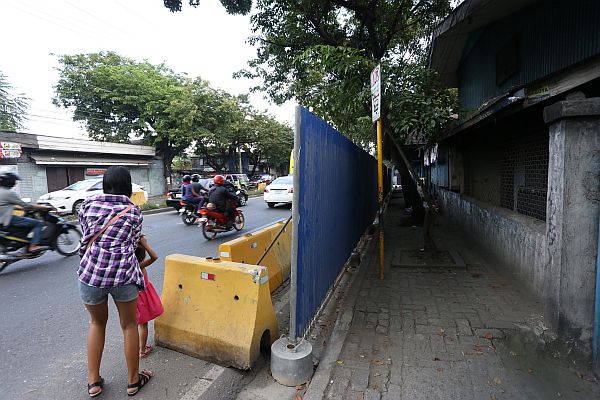
The Department of Public Works and Highways in Central Visayas (DPWH-7) started to fence and put concrete road barriers along the sidewalk of Natalio Bacalso Ave., Barangay Mambaling for the start of the underpass construction, Tuesday.
CDN PHOTO/JUNJIE MENDOZA
Traffic will be heavy in Cebu City’s south district starting today as construction of the underpass project along N. Bacalso Ave. is set to begin after more than two months of delay.
The northbound side of N. Bacalso Ave. in front of Shopwise will be closed to vehicular traffic, except for vehicles of homeowners and business establishments located within the closed area.
The go signal for the project construction was given by Mayor Tomas Osmeña and the Cebu City Transportation Office (CCTO) Monday afternoon after a meeting with representatives of the Department of Public Works and Highways in Central Visayas (DPWH-7).
According to CCTO operations chief Francisco Ouano, the road closure will start as early as 6 a.m. today.
“We will observe the flow of traffic … We will continue observing within one week. After which, we can decide on what changes or adjustments should be done,” he said.
At least 20 traffic enforcers on two shifts will be deployed by CCTO in intersections near the project site.
Access
Construction of the P683–million underpass was almost stalled again after CCTO and Cebu City Councilor Dave Tumulak learned during an inspection conducted over the weekend that some residents living within the area to be closed were unaware that the project was about to begin.
Corrugated sheets set up on the sidewalk to fence off the site was also a cause of concern for Tumulak pointing out that this could be dangerous during emergencies for residents who may find it difficult to get out.
Some establishments, said Tumulak, were also worried about the effect of the road closure on their businesses.
Upon learning of the complaints, DPWH officials immediately went house to house on Monday to explain the project to affected residents in order to win their support.
DPWH project engineer Roy dela Cruz said DPWH was able to get the support of affected residents and businesses after assuring them access to the closed portion of the road by allowing them to use one lane.
“We talked to them and we exchanged contact numbers. We also asked them to sign so we have proof (of the visit),” said Dela Cruz.
Proof of the visit was presented by DPWH to City Hall officials yesterday prompting the mayor to give the green light on the project.
Phase one of the underpass will be finished in three to four months; but the entire project, consisting of six phases, is targeted for completion in two years.
Rerouting
A traffic rerouting plan was earlier released by CCTO for public utility jeepneys (PUJs) which will be diverted to roads such as Cabreros St., Tagunol St., Ganciang St., Ma. Gochan St., Caimito St., and Katipunan St. among others.
Meanwhile, buses, minibuses and trailer trucks with six or more wheels will have to pass through South Road Properties (SRP) in order to avoid the project site.
For private vehicles, Ouano advised car owners to look for their own alternative roads to get to school or work without any problems.
“They should also leave earlier than usual,” he said.
School children
In Mambaling Elementary School, parents were told to accompany their children in going in and out of the school.
School principal Vivian Tagupa met with the parents to inform them about the underpass construction which includes the front area of their school.
The public school has 2,523 students with around 90 percent of them coming from Barangay Mambaling who walk every day from their homes. The rest take public utility vehicles.
To prevent road accidents, the pupils were advised to take the skywalk near the school’s main gate at all times. More barangay tanods will also be deployed to assist the children in crossing the road.
To prevent students from going out of the campus during lunch break, parents were instructed to have their kids bring their lunches to school.
Parents who prefer to bring food for their children will have to register their names with the class advisers for security purposes, said Tagupa.
“Once the students are inside the school, the responsibility is already with the teachers and school,” she added.with Correspondent Michelle Joy L. Padayhag)